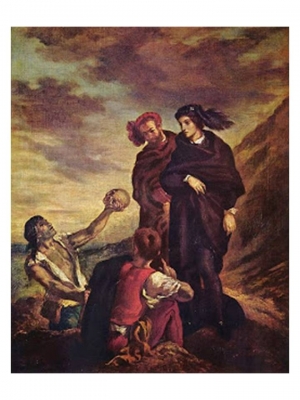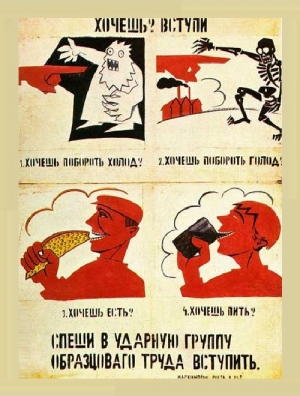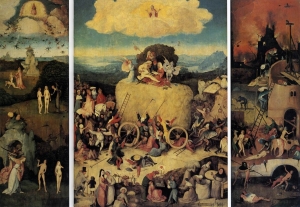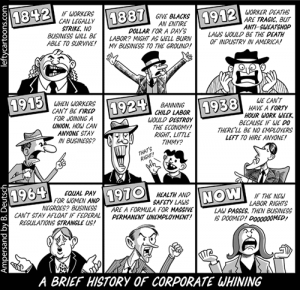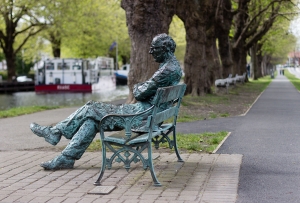
Patrick Kavanagh
On the 50th anniversary of Patrick Kavanagh's death, Jenny Farrell draws out some of the political meanings of Patrick Kavanagh's poem Epic.
The Irish poet Patrick Kavanagh (21 October 1904 – 30 November 1967), who died fifty years ago, is not as well known internationally as he should be. He has been declared the greatest Irish writer after Yeats.
Kavanagh was born in a small village in the Irish countryside, his parents and his people were poor peasants. He left school at 13. He can be compared to John Clare in England and Robert Burns in Scotland. Like them, he wrote about the reality of peasant life, about the poverty of rural life, and the reality of a country dominated by the Catholic Church.
He writes an anti-pastoral, setting reality against a sentimentalised version of country life imagined by the educated city dwellers, or by influential figures such as Ireland’s first Prime Minister, Eamonn de Valera, whose romantic vision was expressed in a famous speech given in 1943, where he states:
The ideal Ireland that we would have, the Ireland that we dreamed of, would be the home of a people who valued material wealth only as a basis for right living, of a people who, satisfied with frugal comfort, devoted their leisure to the things of the spirit – a land whose countryside would be bright with cosy homesteads, whose fields and villages would be joyous with the sounds of industry, with the romping of sturdy children, the contest of athletic youths and the laughter of happy maidens, whose firesides would be forums for the wisdom of serene old age. The home, in short, of a people living the life that God desires that men should live.
This was not the kind of Ireland that corresponded with reality. Kavanagh was the first writer to oppose this view and one of his great works, where he openly presents a realistic picture of rural Ireland is THE GREAT HUNGER.
It’s an ironic title as this is the Irish phrase for the Famine, a time of starvation, a huge national trauma that occurred in the mid-19th century and caused the unnecessary death of a million Irish and the emigration of many more. Kavanagh, however, does not refer to this Famine but to the starvation of the rural population and one farmer in particular, Maguire, of sex and the right to have a wife and a family.
It is a satire in a way, because nature will have its way and not everybody in Kavanagh’s home place lived by the rule of Catholic teachings. Kavanagh’s depiction of rural Ireland was anti-pastoral.
The poem I want to look at here, though, is a much shorter one. It emphasises the fact that if art is honest, unromanticised, unblinkered about its subject, and set in a specific time and place, then it will contain contact points for other people, in other places and times.
EPIC
I have lived in important places, times
When great events were decided; who owned
That half a rood of rock, a no-man’s land
Surrounded by our pitchfork-armed claims.
I heard the Duffys shouting ‘Damn your soul!’
And old McCabe stripped to the waist, seen
Step the plot defying blue cast-steel –
‘Here is the march along these iron stones’
That was the year of the Munich bother. Which
Was more important? I inclined
To lose my faith in Ballyrush and Gortin
Till Homer’s ghost came whispering to my mind.
He said: I made the Iliad from such
A local row. Gods make their own importance.
The title creates the anticipation of a long poem about the deeds of legendary or heroic figures in the past history of a nation. Instead, we have before us a fourteen line poem, a sonnet. It is loosely based on a Shakespearean sonnet, which comes in three sections of four lines each and a two-line conclusion, the couplet.
In the first four lines (quatrain), Kavanagh creates a sense of irony: I have lived in important places, times/ When great events were decided: This is the stuff of an epic poem, we think, until we read on, as Kavanagh seems to joke with us, contradicting that expectation: who owned/ That half a rood of rock, a no-man’s land/ Surrounded by our pitchfork-armed claims. Is this an incident of national importance? It would appear to be the opposite – a petty if at times deadly serious feud over an eighth of an acre (a tiny, tiny piece) of barren land.
In the second quatrain, the focus moves in on the parties ‘at war’; we visualise them and hear what they are shouting. The language the poet employs takes on a military tone: no-man’s land, Surrounded, armed. At the level of sound, the phrase Rood of rock is echoed in Surrounded, reinforcing the connection between the piece of land in question and its military defence. Pitchfork-armed suggests the deadly earnest and aggression accompanying the feud.
These people are prepared to kill for their claim. This evocation of aggression and militarism is continued over the next 3 lines: I heard the Duffys shouting ‘Damn your soul’/ And old McCabe stripped to the waist, seen/ Step the plot defying blue cast-steel - / ‘Here is the march along these iron stones’. The Duffys and McCabe are the two parties to the feud.
However, the line I heard the Duffys shouting ‘Damn your soul’ suggests other Duffys as well – Eoin O’Duffy’s supporters who in the 1930s were Ireland’s own would-be fascists, and extreme Catholics. They too could have been shouting ‘Damn your soul’ in Dublin around the time this poem is set. This connotation subtly introduces a national dimension to the local scene of rural aggression and threat.
It is developed even further in the image of McCabe marching around this tiny piece of land (plot): Step the plot defying blue cast-steel, the word step suggests goose-stepping Nazis and blue cast-steel surely evokes guns as well as describing the pitchforks, indeed the word plot is commonly used to refer to a grave.
Just like the Duffys before, McCabe is also quoted Here is the march along these iron stones. March means both border and to walk in a military fashion or indeed a military tune. And in this line, the stones are no longer simply rock, they are made of iron, just as cannons are.
All these references to warfare do not simply apply to the local row. They are suggestive of the situation in Europe in the 1930s, when O’Duffy’s men were around, and Hitler and Mussolini on the rise, preparing for war. The Spanish Civil war was being waged by anti-fascist republicans from Spain and around Europe against General Franco, who was supported by Germany and Italy. While Eoin Duffy fought on Franco’s side, there were also Irishmen fighting in the International Brigades on the Republican side against Franco.
In this way, the farmers’ readiness to kill reflects the atmosphere in Europe. And, as if to confirm what the reader has been thinking, the opening of the third quatrain confirms the year: That was the year of the Munich bother.
Kavanagh is referring to the Munich Agreement signed in September 1938, where Hitler, Mussolini and the prime ministers of Britain and France agreed to let Germany annex a part of Czechoslovakia - the Sudetenland) in an attempt to avoid a war. Why does Kavanagh describe this agreement as a bother? Because it was treacherous (it excluded Czechoslovakia and the Soviet Union from the decision) and because it was simply a trick by Hitler.
While the poet on one level simply describes the feud between two farmers and then says that this happened in 1938, on another level he has given a sense of the increasing militarism of the 1930s in both Europe and Ireland.
In that sense, the question that follows the full stop in line 9 and goes on to the next line: Which/ Was more important? is not perhaps as simple as it may seem. Important refers back to epic and the poem’s opening lines about important places and great events. The images of the farmers have shown that they reflect their times even if their feuds and behaviour seem at first glance to be unconnected to the momentous events in Europe. But Kavangh continues to play with the ambiguity of the very local, the national and the international: I inclined/ To lose my faith in Ballyrush and Gortin.
Interestingly, he continues the sentence without a full stop and says on the next line (to allow the reader to contemplate this choice for as fraction): Till Homer’s ghost came whispering to my mind. This line brings the reader right back to the notion of epic as Homer is the author of two of the world’s greatest epic, the Iliad and the Odyssey.
The final two lines in a Shakespearean sonnet sum up and comment on the twelve lines that go before. Kavanagh does the same here as he ‘quotes’ Homer: He said: I made the Iliad from such/ A local row. This is perfectly true. The battle of Troy, the story of which the Iliad tells, raged for ten years and was ostensibly over the minor event of Helena’s ‘abduction’ from Greece (Sparta) by the Trojan Paris (she went along with him of her free will). However, what makes Homer’s Iliad an epic is the way he writes about it, not the cause of the battle. The poem’s final statement could be uttered both by Homer or Kavanagh: Gods make their own importance.
This is another reference to the Iliad where the Greek gods all take sides in the battle between the Greeks and the Trojans. It is the fact that Homer fills the poems with the legends of the Greeks that makes this epic poem such a central piece of Greek and indeed European culture.
In other words, even if a poet writes about a local row, the way he writes about it can give it greater political significance, make it important to the way a nation sees itself. Kavanagh is thus not only giving us a sense of the general political situation in Ireland and in Europe, but showing us how poetry itself has a political function in the way it connects the personal and the political.


